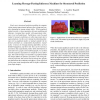Free Online Productivity Tools
i2Speak
i2Symbol
i2OCR
iTex2Img
iWeb2Print
iWeb2Shot
i2Type
iPdf2Split
iPdf2Merge
i2Bopomofo
i2Arabic
i2Style
i2Image
i2PDF
iLatex2Rtf
Sci2ools
CVPR
2011
IEEE
2011
IEEE
Learning Message-Passing Inference Machines for Structured Prediction
Nearly every structured prediction problem in computer vision requires approximate inference due to large and complex dependencies among output labels. While graphical models provide a clean separation between modeling and inference, learning these models with approximate inference is not well understood. Furthermore, even if a good model is learned, predictions are often inaccurate due to approximations. In this work, instead of performing inference over a graphical model, we instead consider the inference procedure as a composition of predictors. Specifically, we focus on message-passing algorithms, such as Belief Propagation, and show how they can be viewed as procedures that sequentially predict label distributions at each node over a graph. Given labeled graphs, we can then train the sequence of predictors to output the correct labelings. The result no longer corresponds to a graphical model but simply defines an inference procedure, with strong theoretical properties, that can ...
Related Content
| Added | 08 Apr 2011 |
| Updated | 29 Apr 2011 |
| Type | Journal |
| Year | 2011 |
| Where | CVPR |
| Authors | Stephane Ross, Daniel Munoz, J. Andrew Bagnell |
Comments (0)

